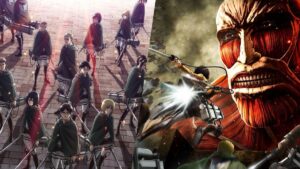
"Baki Hanma", Animation Series with Powerful Fight Scenes, 2024
Baki Hanma
“Baki Hanma” is a thrilling continuation of the “Baki” series, known for its intense martial arts action, over-the-top characters, and minimalistic plot focused on sheer physical prowess and combat. This series, available on Netflix, continues to build on the legacy of Baki Hanma’s journey to surpass his father, Yujiro Hanma, the strongest fighter on Earth.
Season 1: A Familiar Yet Riveting Start
Season 1 of “Baki Hanma” introduces viewers to a familiar setup with Baki continuing his quest to defeat his father. The season kicks off with Baki showcasing his shadow boxing skills against a giant praying mantis, illustrating his growth and fighting prowess. The main plot revolves around Baki getting himself arrested to challenge Biscuit Oliva, a formidable fighter incarcerated in a high-security prison known as “Black Pentagon”.
While the animation remains consistent with its predecessors, featuring exaggerated muscle sizes and detailed fight sequences, it’s the portrayal of the characters that stands out. The personalities of Baki and Oliva are explored in depth, showing their motivations and the essence of their strength. However, some critiques mention that the season’s pacing feels uneven, with the plot stretching thin in places and rushing in others.
Season 2 Part 1: The Introduction of Pickle
The second season takes an intriguing turn with the introduction of Pickle, a prehistoric caveman resurrected in the modern era. This addition brings a unique flavor to the series, blending historical fantasy with martial arts battles. Pickle’s raw, primal strength and ancient combat techniques offer a refreshing contrast to the modern fighters, making the battles visually and thematically engaging.
Pickle’s interactions with other characters, especially Baki, provide both humorous and touching moments, adding layers to the otherwise straightforward fight narrative. The season effectively balances Pickle’s storyline with ongoing subplots involving other characters, although some viewers might find certain episodes either rushed or overly stretched.
Strengths and Weaknesses
Strengths:
- Intense Action Sequences: The fight scenes are a highlight, showcasing high-quality animation and choreography. The detailed depiction of different martial arts techniques combined with the fantastical elements keeps the audience engaged.
- Character Development: Characters like Baki and Pickle are well-developed, with their backstories and motivations clearly fleshed out. This adds emotional depth to the series, making the fights more meaningful.
- Visual Appeal: Despite some criticisms of the exaggerated muscular designs, the animation quality is generally praised. The series maintains a consistent aesthetic that fans of the franchise have come to appreciate.
Weaknesses:
- Pacing Issues: Both seasons have faced criticism for uneven pacing. While the action sequences are compelling, the narrative sometimes feels either too stretched or too rushed, impacting the overall storytelling.
- Character Likeness: Some characters, especially the supporting cast, are seen as less likable or developed compared to Baki. Their actions and personalities sometimes come across as one-dimensional or forced.
Overall Reception
“Baki Hanma” has received mixed to positive reviews. Fans of the series appreciate its commitment to intense, high-stakes martial arts battles and the continuation of Baki’s epic quest. Critics, however, point out its reliance on familiar tropes and the sometimes-grotesque character designs. Despite these critiques, “Baki Hanma” remains a compelling watch for fans of the genre, offering a mix of nostalgia and fresh content with characters like Pickle bringing new dynamics to the series.
In conclusion, “Baki Hanma” successfully continues the legacy of its predecessors, delivering high-octane action and memorable characters. While it has its flaws, particularly in pacing and character depth, it provides a satisfying experience for those invested in Baki’s journey to becoming the strongest.






